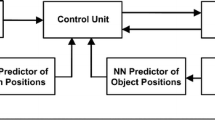Abstract
We propose to redesign a neural network used as a motion generator with bimanual coordination for upper limb prosthesis in order to improve its learning capability. We assumed that the wearer of the prosthesis was a unilateral amputee. In our previous work, we proposed a prosthesis control system using a neural network that learned bimanual coordination in order to implement smooth motion with both hands. However, the previously proposed system has the problem that a neural network cannot generate the desired motion of the prosthesis in special cases. The reason is that the motion generator calculates the desired posture of the prosthesis from the current posture of the healthy arm only, regardless of the current posture of the prosthesis. We propose to use the current posture of both the healthy arm and the prosthesis as neural network inputs in order to solve this problem. In this article, we show that a single neural network whose input was the current posture of both arms could learn the relationships of the coordinated motions of holding boxes of different sizes, and the newly proposed system can calculate the desired motion of the prosthesis in special cases through computer simulations.
Similar content being viewed by others
References
Jacobsen SC, Knutti DF, Johnson RT, et al (1982) Development of the Utah artificial arm. IEEE Trans Biomed Eng 29(4):249–269
Inohira E, Uoi T, Yokoi H (2008) Generalization capability of neural networks for generation of coordinated motion of a hybrid prosthesis with a healthy arm. Int J Innovative Comput Inform Control 4(2):471–483
Kelso JAS (1984) Phase transitions and critical behavior in human bimanual coordination. Am J Physiol 246(6):1000–1004
Inohira E, Yokoi H (2007) An optimal design method for artificial neural networks by using the design of experiments. J Adv Comput Intell Intell Informatics 11(6):593–599
Author information
Authors and Affiliations
Corresponding author
Additional information
This work was presented in part at the 15th International Symposium on Artificial Life and Robotics, Oita, Japan, February 4–6, 2010
About this article
Cite this article
Inohira, E., Yokoi, H. Improvement of a neural network-based motion generator with bimanual coordination for upper limb prosthesis. Artif Life Robotics 15, 504–507 (2010). https://doi.org/10.1007/s10015-010-0855-y
Received:
Accepted:
Published:
Issue Date:
DOI: https://doi.org/10.1007/s10015-010-0855-y




